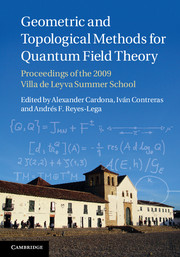 Geometric and Topological Methods for Quantum Field Theory
Geometric and Topological Methods for Quantum Field Theory Book contents
- Frontmatter
- Contents
- List of contributors
- Introduction
- 1 A brief introduction to Dirac manifolds
- 2 Differential geometry of holomorphic vector bundles on a curve
- 3 Paths towards an extension of Chern–Weil calculus to a class of infinite dimensional vector bundles
- 4 Introduction to Feynman integrals
- 5 Iterated integrals in quantum field theory
- 6 Geometric issues in quantum field theory and string theory
- 7 Geometric aspects of the Standard Model and the mysteries of matter
- 8 Absence of singular continuous spectrum for some geometric Laplacians
- 9 Models for formal groupoids
- 10 Elliptic PDEs and smoothness of weakly Einstein metrics of Hölder regularity
- 11 Regularized traces and the index formula for manifolds with boundary
- Index
- References
5 - Iterated integrals in quantum field theory
Published online by Cambridge University Press: 05 May 2013
- Frontmatter
- Contents
- List of contributors
- Introduction
- 1 A brief introduction to Dirac manifolds
- 2 Differential geometry of holomorphic vector bundles on a curve
- 3 Paths towards an extension of Chern–Weil calculus to a class of infinite dimensional vector bundles
- 4 Introduction to Feynman integrals
- 5 Iterated integrals in quantum field theory
- 6 Geometric issues in quantum field theory and string theory
- 7 Geometric aspects of the Standard Model and the mysteries of matter
- 8 Absence of singular continuous spectrum for some geometric Laplacians
- 9 Models for formal groupoids
- 10 Elliptic PDEs and smoothness of weakly Einstein metrics of Hölder regularity
- 11 Regularized traces and the index formula for manifolds with boundary
- Index
- References
Summary
Abstract
These notes are based on a series of lectures given to a mixed audience of mathematics and physics students at Villa de Leyva in Colombia in 2009. The first half is an introduction to iterated integrals and polylogarithms, with emphasis on the case ℙ1\{0, 1, ∞}. The second half gives an overviewof some recent results connecting them with Feynman diagrams in perturbative quantum field theory.
Introduction
The theory of iterated integralswas first invented by K. T. Chen in order to construct functions on the (infinite-dimensional) space of paths on a manifold, and has since become an important tool in various branches of algebraic geometry, topology and number theory. It turns out that this theory makes contact with physics in (at least) the following ways:
the theory of Dyson series,
conformal field theory and the KZ equation,
the Feynman path integral and calculus of variations,
Feynman diagram computations in perturbative quantum field theory (QFT).
The relation between Dyson series and Chen's iterated integrals is more or less tautological. The relationship with conformal field theory is well-documented, and we discuss a special case of the KZ equation in these notes. The relationship with the Feynman path integral is perhaps the deepest and most mysterious, and we say nothing about it here. Our belief is that a complete understanding of the path integral will only be possible via the perturbative approach, and by first understanding the relationship with (2) and (4). Thus the first goal of these notes is to try to explain why iterated integrals should occur in perturbative quantum field theory.
- Type
- Chapter
- Information
- Geometric and Topological Methods for Quantum Field TheoryProceedings of the 2009 Villa de Leyva Summer School, pp. 188 - 240Publisher: Cambridge University PressPrint publication year: 2013
References
- 18
- Cited by


